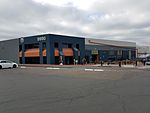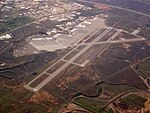Flying Leatherneck Aviation Museum
Aerospace museums in CaliforniaMarine Corps museums in the United StatesMilitary and war museums in CaliforniaMuseums in San DiegoUnited States Marine Corps aviation ... and 1 more
United States Marine Corps pilots of World War II

The Flying Leatherneck Aviation Museum is a United States Marine Corps aviation museum currently located at Marine Corps Air Station Miramar, San Diego, California. The museum contains exhibits and artifacts relating to the history and legacy of United States Marine Corps Aviation. The outdoor exhibits include 31 historical aircraft, multiple military vehicles and equipment. Indoor exhibits feature photographs, artifacts and artwork from the early days of aviation to the present.
Excerpt from the Wikipedia article Flying Leatherneck Aviation Museum (License: CC BY-SA 3.0, Authors, Images).Flying Leatherneck Aviation Museum
Anderson Rigel Avenue, San Diego
Geographical coordinates (GPS) Address External links Nearby Places Show on map
Geographical coordinates (GPS)
| Latitude | Longitude |
|---|---|
| N 32.891111111111 ° | E -117.13916666667 ° |
Address
Flying Leathernecks Aviation Museum
Anderson Rigel Avenue
92126 San Diego
California, United States
Open on Google Maps







